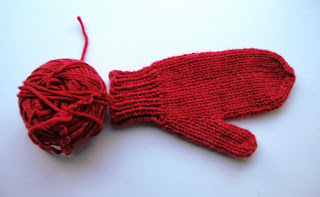This means that I need warm handcoverings earlier in the winter -- and later into the spring -- than most.
And when the weather really turns bad, I have to get serious about my handcoverings. I have consulted a knitting rheumatologist (hello Dr. N, if you're reading!) about this, and she made a number of key recommendations.
- Mittens are always warmer than gloves - it's better to have air circulating, and if your fingers are together they can share the warmth.
- It's best if the mitten is a bit loose, to encourage that circulation.
- Layering is good. Two layers of mittens will trap warm air between them.
Over the years, I've developed a few solutions.
As the evenings get chilly in September and October, I start wearing a pair of small fingerless mitts when I'm outside. These provide some basic coverage for cooler days, but are small and fitted, leaving enough movement that I can do whatever I need to -- type, knit, make coffee -- without having to take them off.
These are my fingerless mitt pattern from my Knit Accessories book, worked in fingering weight. The book has a worsted and a fingering-weight version. They're worked top-down so they are great for using up leftovers. Being small-footed, I can usually get a pair of these mitts and a pair of socks out of 100gm of sock yarn.
By mid-November, the fingerless mitts stay on pretty much all day, even in the house. I live in a big old drafty loft with high ceilings, and it can be pretty chilly at home. And I layer a pair of wool mittens on top. At first, they're a pair of light single-layer mittens - I like these 100% merino Icebreaker ones because they're very small and light, lined with a wooly fleece.
And then another few degrees cooler, and the other pair becomes a pair of thicker hand-knit mittens.
I'm very fond of these red ones, worked from my Basic Mittens pattern in my Knit Accessories book. As with all the patterns in that book, there's multiple gauges available - there's a worsted weight and a chunky weight pattern, which can also be worked with double-stranded worsted weight. The red pair are Cascade 220, the orange pair is Classic Elite mohair.
Or in a chunky/bulky weight, like this pair-to-be, in Sweet Georgia Superwash Chunky.
Warmer still are stranded colourwork mittens, as the floats on the wrong side of the work create a lining.
These are the Morse Code mittens, as published in Knitty.
And then as it gets colder, I change up to these: they're stranded colourwork mitts, felted to get rid of those pesky little holes in the fabric. For extra warmth I've lined them with a 'Thinsulate' fleece liner that I harvested from a pair of inexpensive acrylic mittens. Pattern recklessly improvised, using Briggs & Little Heritage yarn.
But when the weather truly turns foul, I grudgingly turn to a more modern solution: technical fabrics. I have a pair of Arctic-rated mittens like these from Mountain Equipment Co-op (the Canadian equivalent of REI), but still always with my fingerless mitts underneath - that way, if I need to take my hands out of my mitts, to answer my phone, when popping into the coffee shop, to grab a plastic bag for dog-related stuff - then I've still got some protection.
So yes, chances are, if you see me between the middle of September and the middle of April, I'll be wearing my fingerless mitts, even indoors. I actually have several pairs so I can wash them every couple of days. I figure that between coffee dribbles and the general wear-and-tear of everyday use, they need a wash. One of the reason sock yarn is so good for them - I can throw them in for a wash with a load of socks.
I even have a Christmas pair, made with yarn leftover from last year's Christmas socks.













1 comment:
i have reynaud's, also and was wondering about thrummed mittens. have you ever tried them? i am thinking that will be my next project, to wear when i take my granddaughter to her ice skating lessons.
Post a Comment